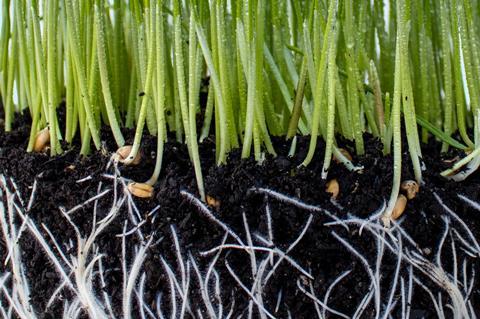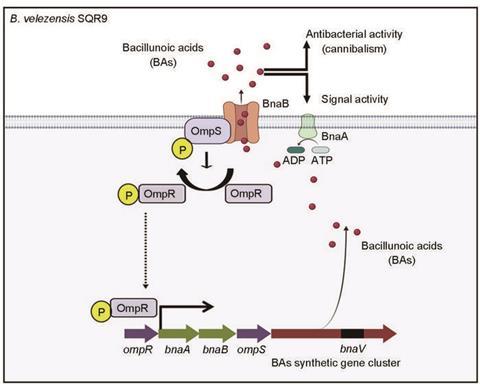When considering a bacterial population as a multicellular community, it is imperative to understand the inherent roles of maintaining homeostasis and viability in response to environmental factors.

Cannibalism is a strategy to cope with nutrient deficiency in the environment, which maintains survival of the Bacillus population. Although cannibalism is well-investigated in Bacillus subtilis, the model species of Bacillus, its mechanism remains unknown in other Bacillus species.
Beneficial rhizobacterium
Bacillus velezensis SQR9 is a well-studied beneficial rhizobacterium that can colonize plant roots efficiently through biofilm formation. The strain SQR9 harbours a novel genomic island 3 (GI3), which encodes synthetases (BnaD-Y) of the novel branch-chain fatty acids, bacillunoic acids; an ABC transporter (BnaAB) to export toxic bacillunoic acids; a response regulator (OmpR) and a histidine kinase (OmpS).
By constructing the genetic mutant that does not synthesize bacillunoic acids (SQR9ΔbnaV, the beta-ketoacyl synthase deletion mutant) or is deficient in self-immunity against bacillunoic acids (SQR9ΔbnaA, the ATPase gene deletion mutant), the Nanjing Agricultural University authors of this study, published in Science Bulletin, found that in terms of biofilm density, dead cell proportion in the biofilm, and extracellular DNA in the biofilm, SQR9ΔbnaA was significantly higher than the wild-type, and SQR9ΔbnaV was significantly lower than the wild-type, indicating that bacillunoic acids mediate cell lysis (cannibalism) and eDNA release in a subpopulation of cells, which promote biofilm formation.
Bacillunoic acids
By fusing the promoter region of the bnaAB operon with the gfp reporter gene, they found that bacillunoic acids can induce the expression of the immunity gene bnaA.
In addition, it was observed that the population of strain SQR9 were differentiated into bacillunoic acids-producing and nonproducing cells, and nonproducers are sensitive to bacilllunoic acids, while the producers are immune to the toxins. Thus, cannibalism is involved in cell differentiation of strain SQR9 population.
Cannibalism mechanism
Concerning the mechanism of cannibalism, the authors focused on the response regulator gene ompR and the histidine kinase gene ompS, which are adjacent to the immunity genes bnaAB. They demonstrated that bacillunoic acids regulate the expression of the bnaAB operon via phosphorylation of OmpR in TCS (OmpS/OmpR).

Thus, a subpopulation of cells within the biofilm differentiate into cannibals and secrete toxic bacillunoic acids. Upon activation by bacillunoic acids, the response regulator OmpR of the TCS (OmpS/OmpR) activates transcription of the ABC transporter BnaAB, which pumps bacillunoic acids out of the cell for self-protection. The exported toxins could lyse toxin nonproductive siblings that lack this self-immunity, thereby releasing eDNA to promote biofilm formation.
New observation
In summary, the authors report that bacillunoic acids-mediated cannibalism enhanced biofilm formation of B. velezensis SQR9. Intriguingly, this is the first report of a Bacillus strain obtaining a complete set of elements to enable it to cannibalize via horizontal gene transfer.
Bacillunoic acids are responsible for killing cells involved in cannibalism, which are sacrificed for the benefit of the entire population. B. velezensis SQR9 population gains an evolutionary benefit from this precision system.







No comments yet